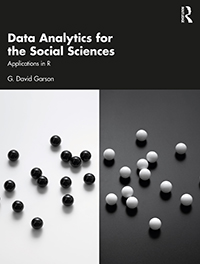

Taylor and Francis Group is part of the Academic Publishing Division of Informa PLC
This site is operated by a business or businesses owned by Informa PLC and all copyright resides with them. Informa PLC's registered office is 5 Howick Place, London SW1P 1WG. Registered in England and Wales. Number 3099067.

Welcome to the companion website for Data Analytics for the Social Sciences. Here you will find the online resources that have been designed to accompany the textbook in the form of datasets, reading resources, review questions and appendices for students, along with PowerPoint slides and review questions with answers for instructors.
Data Analytics for the Social Sciences is an introductory, graduate-level treatment of data analytics for social science. It features applications in the R language, arguably the fastest growing and leading statistical tool for researchers.
The book starts with an ethics chapter on the uses and potential abuses of data analytics. Chapters 2 and 3 show how to implement a broad range of statistical procedures in R. Chapters 4 and 5 deal with regression and classification trees and with random forests. Chapter 6 deals with machine learning models and the "caret" package, which makes available to the researcher hundreds of models. Chapter 7 deals with neural network analysis and Chapter 8 with network analysis and visualization of network data. A final chapter treats text analysis, including web scraping, comparative word frequency tables, word clouds, word maps, sentiment analysis, topic analysis, and more. All empirical chapters have two "Quick Start" exercises designed to allow quick immersion in chapter topics, followed by "In Depth" coverage. Data are available for all examples and runnable R code is provided in a "Command Summary". An appendix provides an extended tutorial on R and RStudio. Over 30 online supplements for each chapter provide "books within the book" on a variety of topics, such as agent-based modelling.
Rather than focusing on equations, derivations and proofs, this book emphasises hands-on obtaining of output for various social science models and on how to interpret the output. It is suitable for all advanced level undergraduate and postgraduate students learning statistical data analysis.